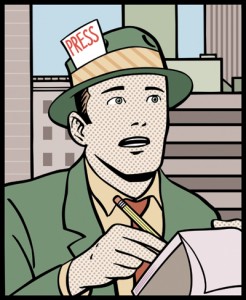Unit 1 covers the first set of lessons of the News Literacy course and introduces participants to issues that prompted the development of the course. Each of the lessons are described below:
 Lesson 1 - What is News Literacy
Lesson 1 - What is News Literacy
An introduction and overview of the course, highlighted by an outline of the role of a free press in a democratic society and examples of current print and broadcast stories that illustrate why news literacy matters to students – and society. We define “the news media,” and put the course in the context of the accelerating communications revolution, ranging from Johann Gutenberg to Jon Stewart. Students leave this class with an understanding of the purpose of the First Amendment in our society and the core definition of News Literacy: The ability to judge the credibility and reliability of news reports–and why that matters to them.
.
Lesson 2 - The Power of Information and the Press
We explore the universal need to receive and share information and the function that news has played in every recorded society: to alert, to connect and to divert. Paying attention to disaster and celebrity stories – even dog stories – is embedded deeply in our DNA. We then examine the specific cases in the United States and the role technology has played in amplifying information – from smoke signals to television – and how this also has enabled the sender to control the news. Students leave this class with an understanding of why there is a need for a free flow of information in American and other cultures and why some people are willing to kill (and journalists are willing to die) in the battle to control information.
.
Lesson 3 - Know Your Neighborhood
What makes journalism different from other kinds of information? The first rule for a smart news consumer is this: always know what information “neighborhood” you’re in. This lecture explores the differences between news, propaganda, publicity, advertising, entertainment and raw information. Students begin work on an Information Grid that defines these “neighborhoods.” In the journalism neighborhood, a news consumer should always find three key values: verification, independence and accountability. But the lines on the grid are blurring, often by design, and it’s easy to be deceived as to what journalism is and who is a journalist.
.
Lesson 4 - What is News and Why?
What makes some information news? This class examines news drivers, news values and how the news process works. What is the decision-making process that determines whether a story gets published or broadcast? Who decides? How do editors balance the interesting and the important? What is “news play,” or presentation, and why does it matter? What is proportionality? What is sensationalism? Are news decisions driven by the profit motive or social responsibility or some combination of the two? Students examine the question of whether there is too much bad news.
.
Return to the main Table of Contents

